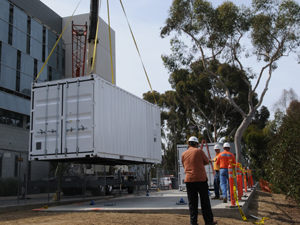Intel Donates 200 Microprocessors to Promote Calit2's Visualization Research at UC San Diego
San Diego, CA, Sept. 8, 2008 — In a gesture of support for the "extreme visualization" research being done by the UC San Diego division of the California Institute for Telecommunications and Information Technology (Calit2), Intel Corporation has donated 200 quad-core microprocessors to Calit2's Falko Kuester, professor of visualization and virtual reality.
|
"We've long moved away from just processing and viewing the data to visual analytics," explained Prof. Kuester. "If you have a problem and you need to solve it, you have to be able to dissect your data interactively at many scales and dimensions. The Intel microprocessors contain four individual computational cores and can do extremely fast processing in parallel using fairly high-frequency microchips. This is the bandwidth that we need for the type of computation we're doing."
The Quad-Core Xeon E5440 microprocessors — valued at $128,000 — will be used primarily to provide computational power for UCSD's Project GreenLight, an initiative to develop more energy-efficient 'green' computer processing and storage systems. The many data intensive research projects that Calit2 spearheads, pose huge processing, storage and networking challenges, which will be directly or indirectly tackled with these processors.
"We are pleased to support Professor Falko Kuester's exciting research, which is rapidly advancing the state of the art in ultra-scale visualization and delivery of the results at resolutions that match the 287 mega pixel provided by HIPerSpace (Calit'2 Highly Interactive Paralleized Display Space)," said Intel Higher Education Program Manager Scott Buck. "These displays not only have spectacular visual quality, but enable scientists using them to make breakthroughs in the fields of medical research, art diagnostics and green computing."
The GreenLight project, which is funded by the National Science Foundation, gets its name from its plan to connect scientists and their labs to more energy-efficient 'green' computer processing and storage systems using photonics — light over optical fiber. At least 128 of the microprocessors donated by Intel will be used to power one of the project's two eco-friendly Sun Modular Datacenter S20s. In addition to storing and rendering data on the Intel-equipped Sun Datacenters, researchers will be able to provide a real-time glimpse at the computing environment inside the modular units by way of Calit2's HIPerSpace, StarCAVE, and Varrier virtual reality displays.
Explained Kuester: "The exciting part for HIPerSpace, StarCAVE and the Varrier is that they will be the visual termination points for the GreenLight computing and storage cluster." The cluster, which can accommodate up to 280 servers, features a closed-loop water-cooling system that can reduce cooling costs by up to 40 percent when compared to traditional server rooms. This allows the unit to cool 25 kilowatts per rack, roughly five times the cooling capacity of typical datacenters.
Added Kuester: "The GreenLight environment is carefully controlled and has no windows. Yet we still want to see what happens inside at the container, rack, blade and processor level, everywhere energy is being consumed and heat generated. So, the virtual reality displays will be the 3-D window into the GreenLight container that will allow researchers to see what generally cannot be seen, in a fully interactive, virtual model of the entire system and its components.
"The UCSD community at large will benefit from this carbon-conscious approach to computing because of their pervasive access to the GreenLight environment," he continued. "This type of processing environment provides domain scientists the opportunity to change parameters on the fly and see what happens."
|
Both the Varrier and HIPerSpace displays will also directly benefit from the Intel donation. The Varrier display will receive 64 of the microprocessors, and Kuester is hoping to reserve a few to establish a better tile-to-node balance on the HIPerSpace Wall (HIPerSpace is already outfitted with the bulk of 80 microprocessors that were previously donated by Intel).
In addition to the improved visualization capabilities of the Varrier and HIPerSpace displays, the Center for Interdisciplinary Science in Arts, Architecture and Archeology (CISA3) will also be using multiple microprocessors to outfit its Point Star system, a new set of processing and rendering nodes designed to visualize massive data from its Battle of Anghiari project. Point Star can visualize huge point cloud datasets and multispectral data — data that is generally computationally and memory intensive to generate.
"The idea of 'seeing what cannot be seen' applies to both the GreenLight project and the research into art diagnostics at CISA3," Kuester said. "We're using these visualization technologies to see what cannot be seen in a work of art. So with both 'extreme computing' and 'extreme art,' the motivation is very similar, and I think that's beautiful."
Related Links
Intel
Sun Modular Datacenter
CISA3
Media Contacts
Tiffany Fox, (858) 246-0353, tfox@ucsd.edu


